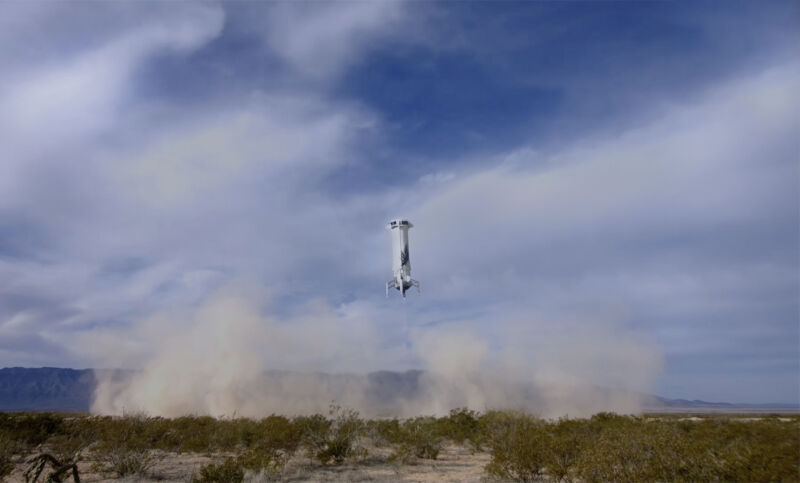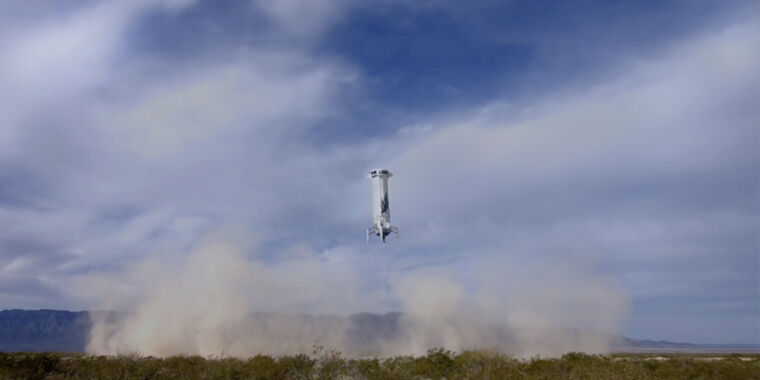Blue Origin’s suborbital rocket flies for first time in 15 months

Enlarge / Blue Origin’s New Shepard booster comes in for landing in West Texas at the conclusion of Tuesday’s suborbital flight.
Blue Origin
With redesigned engine components, Blue Origin’s New Shepard rocket took off from West Texas and flew to the edge of space on Tuesday with a package of scientific research and technology demonstration experiments.
This was the first flight of Blue Origin’s 60-foot-tall (18-meter) New Shepard rocket since September 12, 2022, when an engine failure destroyed the booster and triggered an in-flight abort for the vehicle’s pressurized capsule. There were no passengers aboard for that mission, and the capsule safely separated from the failed booster and parachuted to a controlled landing.
The flight on Tuesday also didn’t carry people. Instead, Blue Origin, Jeff Bezos’s space company, lofted 33 payloads from NASA, research institutions, and commercial companies. Some of these payloads were flown again on Tuesday’s launch after failing to reach space on the failed New Shepard mission last year. Among these payloads were an experiment to demonstrate hydrogen fuel cell technology in microgravity and an investigation studying the strength of planetary soils under different gravity conditions.
Blue Origin’s capsule, mounted on top of the rocket, also flew 38,000 postcards submitted by students through Club for the Future, the company’s nonprofit.
For Tuesday’s return-to-flight mission, the New Shepard rocket ignited its BE-3PM engine and climbed away from Blue Origin’s remote launch site near Van Horn, Texas, at 10: 42 am CST (16: 42 UTC). The hydrogen-fueled engine fired for more than two minutes, then shut down as scheduled as the rocket continued coasting upward, reaching an altitude of more than 347,000 feet (106 kilometers).
The booster returned for a precision propulsive landing a short distance from the launch pad, and Blue Origin’s capsule deployed three parachutes to settle onto the desert floor, completing a 10-minute up-and-down flight.
Blue Origin has launched 24 missions with its reusable New Shepard rocket, including six flights carrying people just over the Kármán line, the internationally recognized boundary of space 100 kilometers above Earth.
“A special thank you to all of our customers who flew important science today and the students who contributed postcards to advance our future of living and working in space for the benefit of Earth,” said Phil Joyce, Blue Origin’s senior vice president for the New Shepard program, in a statement. “Demand for New Shepard flights continues to grow and we’re looking forward to increasing our flight cadence in 2024.”
Blue Origin will fly people again “soon”
It took 15 months for Blue Origin to return to flight with New Shepard, but Tuesday’s successful launch puts the company on a path to resuming human missions. Most of Blue Origin’s customers for these suborbital flights have been wealthy individuals or special guests invited to strap in for a ride to space. Blue Origin’s passengers have included Bezos, aviation pioneer Wally Funk, and actor William Shatner, eager for a taste of spaceflight. New Shepard passengers experience a few minutes of microgravity before returning to Earth.
Blue Origin hasn’t disclosed its ticket price, but seats on a New Shepard flight last year reportedly sold for $1.25 million. This is more than double the price for a seat on Virgin Galactic’s suborbital spaceship.
So when will Blue Origin start flying people again? “Following a thorough review of today’s mission, we look forward to flying our next crewed flight soon,” said Erika Wagner, a longtime Blue Origin manager who co-hosted the company’s webcast of Tuesday’s flight.
But “soon” is a conveniently vague term. In March, when Blue Origin announced the results of its investigation into last year’s launch failure, the company said it would return to flight “soon” with New Shepard. Nine months later, New Shepard finally flew again.
Engineers probing the New Shepard accident last year concluded a nozzle failure on the rocket’s BE-3PM was the direct cause of the launch failure. The engine operated at higher temperatures than expected, leading to thermal damage to the nozzle, Blue Origin announced earlier this year.
Blue Origin said corrective actions to address the cause of the failure included design changes to the engine combustion chamber and adjustments to operating parameters. These changes were expected to reduce operating temperatures. Engineers also redesigned parts of the nozzle to help it better handle thermal and dynamic loads, the company said.
In September, the Federal Aviation closed its investigation into the New Shepard launch failure, and Blue Origin targeted an uncrewed return-to-flight mission in early October. However, Ars previously reported that an additional two-month delay was caused by an issue with certifying an engine part intended for flight.
The long-term grounding of the New Shepard rocket caused speculation about the program’s future, particularly at a time when Blue Origin is ramping up preparations for the inaugural flight of the much larger orbital-class New Glenn launcher. Last year’s launch failure left Blue Origin with just one New Shepard booster in its inventory—the rocket that made its ninth flight to space on Tuesday.
This particular booster has been exclusively used for uncrewed research missions. Blue Origin hasn’t confirmed whether it has another New Shepard rocket in production for human flights.
But statements from Blue Origin officials Tuesday suggest New Shepard has a future. Wagner said Blue Origin aims to open New Shepard missions to researchers on future flights, allowing scientists to directly work with their experiments in microgravity.
Blue Origin’s suborbital rocket flies for first time in 15 months Read More »
